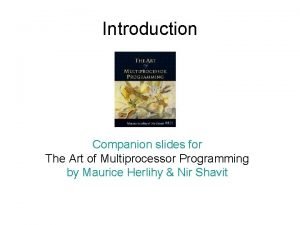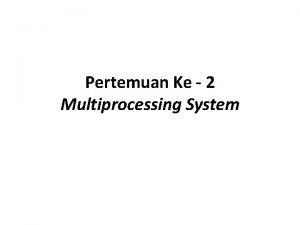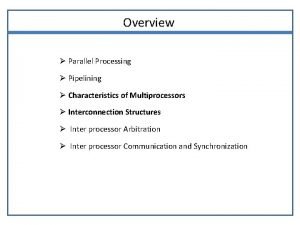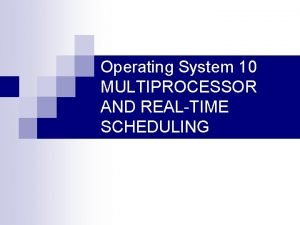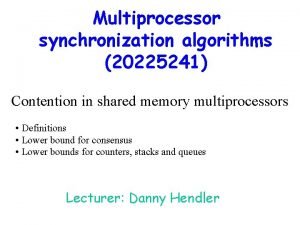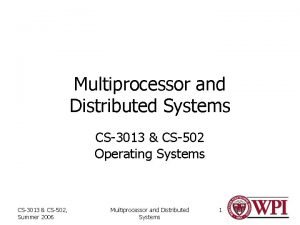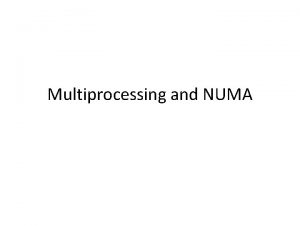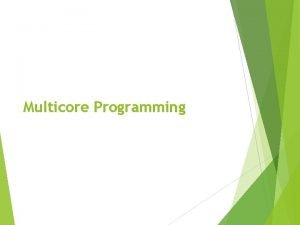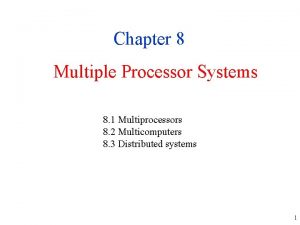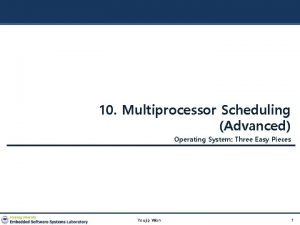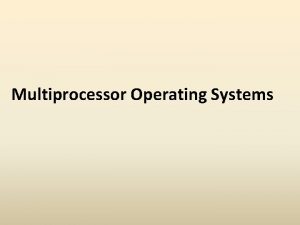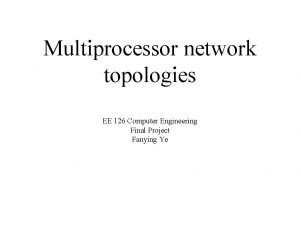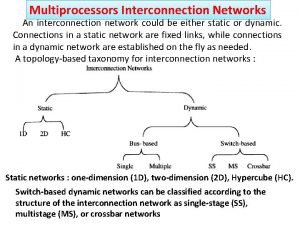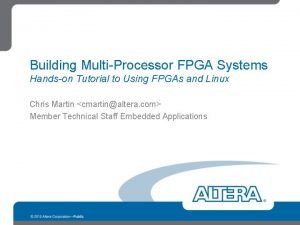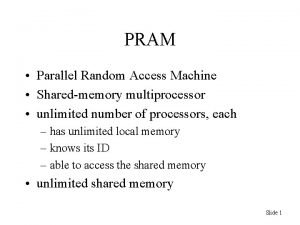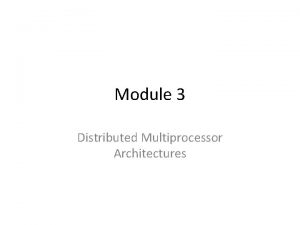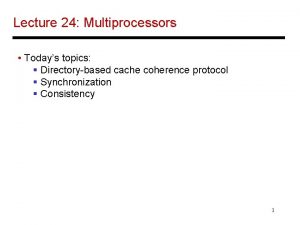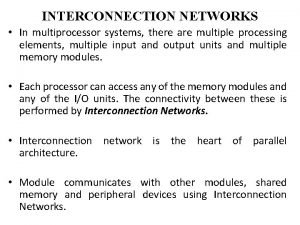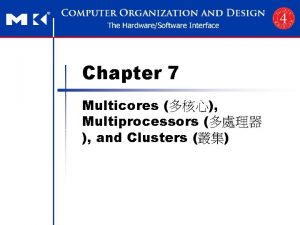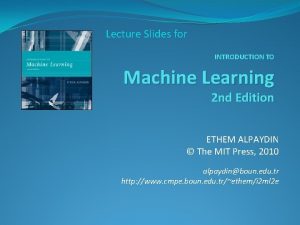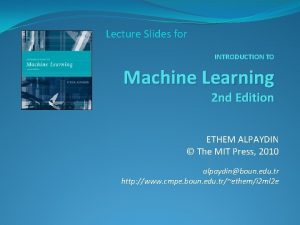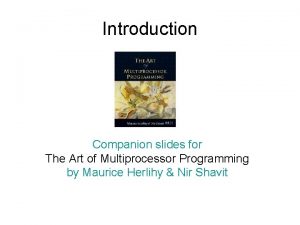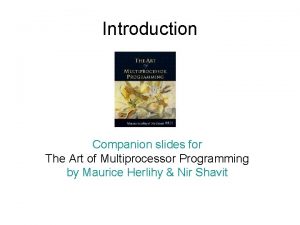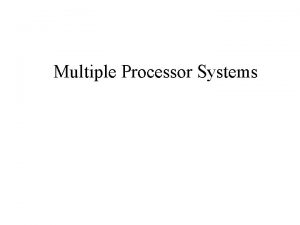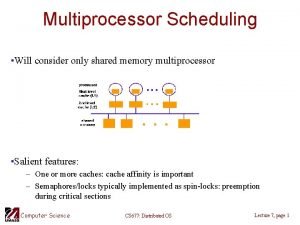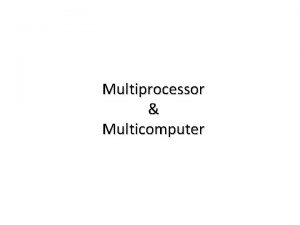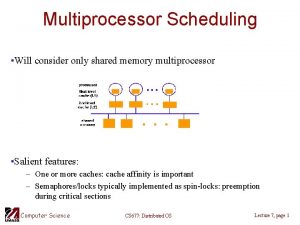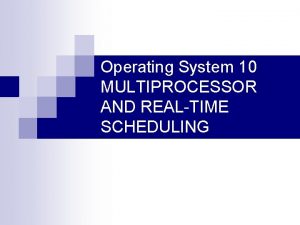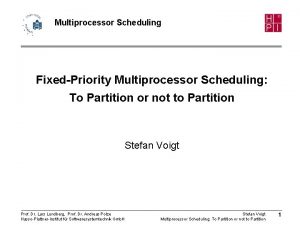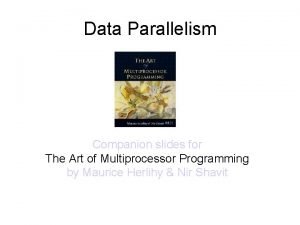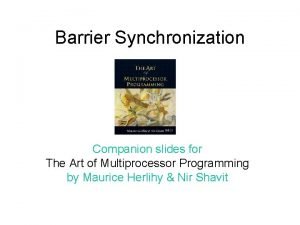Introduction Companion slides for The Art of Multiprocessor



























































- Slides: 59

Introduction Companion slides for The Art of Multiprocessor Programming by Maurice Herlihy & Nir Shavit

Moore’s Law Transistor count still rising Clock speed flattening sharply Art of Multiprocessor Programming 2

Why do we care? • Time no longer cures software bloat – The “free ride” is over • When you double your program’s path length – You can’t just wait 6 months – Your software must somehow exploit twice as much concurrency Art of Multiprocessor Programming 3

Nearly Extinct: the Uniprocesor cpu memory Art of Multiprocessor Programming 4

The New Boss: The Multicore Processor (CMP) All on the same chip cache Bus shared memory Art of Multiprocessor Programming Sun T 2000 Niagara 5

Traditional Scaling Process 7 x Speedup 1. 8 x 3. 6 x User code Traditional Uniprocessor Time: Moore’s law Art of Multiprocessor Programming 6

Ideal Scaling Process 7 x Speedup 1. 8 x 3. 6 x User code Multicore Unfortunately, not so simple… Art of Multiprocessor Programming 7

Actual Scaling Process Speedup 1. 8 x 2 x 2. 9 x User code Multicore Parallelization and Synchronization require great care… Art of Multiprocessor Programming 8

Multicore Programming: Course Overview • Fundamentals – Models, algorithms, impossibility • Real-World programming – Architectures – Techniques Art of Multiprocessor Programming 9

Sequential Computation thread memory object Art of Multiprocessor Programming 10

thr ead s Concurrent Computation memory object Art of Multiprocessor Programming 11

Asynchrony • Sudden unpredictable delays – Cache misses (short) – Page faults (long) – Scheduling quantum used up (really long) Art of Multiprocessor Programming 12

Model Summary • Multiple threads – Sometimes called processes • Single shared memory • Objects live in memory • Unpredictable asynchronous delays Art of Multiprocessor Programming 13

Road Map • We are going to focus on principles first, then practice – Start with idealized models – Look at simplistic problems – Emphasize correctness over pragmatism – “Correctness may be theoretical, but incorrectness has practical impact” Art of Multiprocessor Programming 14

Concurrency Jargon • Hardware – Processors • Software – Threads, processes • Sometimes OK to confuse them, sometimes not. Art of Multiprocessor Programming 15

Parallel Primality Testing • Challenge – Print primes from 1 to 1010 • Given – Ten-processor multiprocessor – One thread per processor • Goal – Get ten-fold speedup (or close) Art of Multiprocessor Programming 16

Load Balancing 1 109 2· 109 P 0 P 1 … … 1010 P 9 • Split the work evenly • Each thread tests range of 109 Art of Multiprocessor Programming 17

Procedure for Thread i void prime. Print { int i = Thread. ID. get(); // IDs in {0. . 9} for (j = i*109+1, j<(i+1)*109; j++) { if (is. Prime(j)) print(j); } } Art of Multiprocessor Programming 18

Issues • Higher ranges have fewer primes • Yet larger numbers harder to test • Thread workloads – Uneven – Hard to predict Art of Multiprocessor Programming 19

Issues • Higher ranges have fewer primes • Yet larger numbers harder to test • Thread workloads – Uneven – Hard to predict d e ct e j re • Need dynamic load balancing Art of Multiprocessor Programming 20

Shared Counter 19 18 each thread takes a number 17 Art of Multiprocessor Programming 21

Procedure for Thread i int counter = new Counter(1); void prime. Print { long j = 0; while (j < 1010) { j = counter. get. And. Increment(); if (is. Prime(j)) print(j); } } Art of Multiprocessor Programming 22

Procedure for Thread i Counter counter = new Counter(1); void prime. Print { long j = 0; while (j < 1010) { j = counter. get. And. Increment(); if (is. Prime(j)) Shared counter print(j); object } } Art of Multiprocessor Programming 23

Where Things Reside void prime. Print { int i = Thread. ID. get(); // IDs in {0. . 9} for (j = i*109+1, j<(i+1)*109; j++) { if (is. Prime(j)) print(j); } } Local variables code cache Bus 1 Bus shared memory shared counter Art of Multiprocessor Programming 24

Procedure for Thread i Counter counter = new Counter(1); void prime. Print { long j = 0; while (j < 1010) { j = counter. get. And. Increment(); if (is. Prime(j)) print(j); Stop when every } value taken } Art of Multiprocessor Programming 25

Procedure for Thread i Counter counter = new Counter(1); void prime. Print { long j = 0; while (j < 1010) { j = counter. get. And. Increment(); if (is. Prime(j)) print(j); } } Increment & return each new value Art of Multiprocessor Programming 26

Counter Implementation public class Counter { private long value; public long get. And. Increment() { return value++; } } Art of Multiprocessor Programming 27

Counter Implementation public class Counter { private long value; } public long get. And. Increment() { , d a e r return value++; h t s e d l a g e r } h t r sin t o n f e r K r u O c n o c r ot fo n Art of Multiprocessor Programming 28

Why? int a = 0; void increment() { a += 1; ; } clang -S -c increment. c movl _a(%rip), %eax addl $1, %eax movl %eax, _a(%rip) Art of Multiprocessor Programming 29

What It Means public class Counter { private long value; public long get. And. Increment() { return value++; temp = value; } value = temp + 1; } return temp; Art of Multiprocessor Programming 30

Not so good… Value… 1 2 read 1 write 2 3 read 2 read 1 2 write 3 write 2 time Art of Multiprocessor Programming 31

Is this problem inherent? !! !! write read If we could only glue reads and writes together… Art of Multiprocessor Programming 32

Challenge public class Counter { private long value; public long get. And. Increment() { temp = value; value = temp + 1; return temp; } } Art of Multiprocessor Programming 33

Challenge public class Counter { private long value; public long get. And. Increment() { temp = value; value = temp + 1; return temp; } Make these } steps atomic (indivisible) Art of Multiprocessor Programming 34

Hardware Solution public class Counter { private long value; public long get. And. Increment() { temp = value; value = temp + 1; return temp; } } Read. Modify. Write() instruction 35 Art of Multiprocessor Programming

An Aside: Java™ public class Counter { private long value; public long get. And. Increment() { synchronized { temp = value; value = temp + 1; } return temp; } } Art of Multiprocessor Programming 36

An Aside: Java™ public class Counter { private long value; } public long get. And. Increment() { synchronized { temp = value; value = temp + 1; } return temp; } Synchronized block Art of Multiprocessor Programming 37

An Aside: Java™ public class Counter { private long value; Mutual Exclusion public long get. And. Increment() { synchronized { temp = value; value = temp + 1; } return temp; } } Art of Multiprocessor Programming 38

Why do we care? • We want as much of the code as possible to execute concurrently (in parallel) • A larger sequential part implies reduced performance • Amdahl’s law: this relation is not linear… Art of Multiprocessor Programming 39

Amdahl’s Law Speedup= 1 -thread execution time n-thread execution time Art of Multiprocessor Programming 40

Amdahl’s Law Speedup= – Art of Multiprocessor Programming 41

Amdahl’s Law Parallel fraction Speedup= – Art of Multiprocessor Programming 42

Amdahl’s Law Sequential fraction Speedup= Parallel fraction – Art of Multiprocessor Programming 43

Amdahl’s Law Sequential fraction Speedup= Number of threads Parallel fraction – Art of Multiprocessor Programming 44

Example • Ten processors • 60% concurrent, 40% sequential • How close to 10 -fold speedup? Art of Multiprocessor Programming 45

Example • Ten processors • 60% concurrent, 40% sequential • How close to 10 -fold speedup? Speedup = 2. 17= Art of Multiprocessor Programming 46

Example • Ten processors • 80% concurrent, 20% sequential • How close to 10 -fold speedup? Art of Multiprocessor Programming 47

Example • Ten processors • 80% concurrent, 20% sequential • How close to 10 -fold speedup? Speedup = 3. 57= Art of Multiprocessor Programming 48

Example • Ten processors • 90% concurrent, 10% sequential • How close to 10 -fold speedup? Art of Multiprocessor Programming 49

Example • Ten processors • 90% concurrent, 10% sequential • How close to 10 -fold speedup? Speedup = 5. 26= Art of Multiprocessor Programming 50

Example • Hundred processors • 90% concurrent, 10% sequential • How close to 100 -fold speedup? Art of Multiprocessor Programming 51

Example • Hundred processors • 90% concurrent, 10% sequential • How close to 100 -fold speedup? Speedup = 9. 17= Art of Multiprocessor Programming 52

Example • Ten processors • 99% concurrent, 01% sequential • How close to 10 -fold speedup? Art of Multiprocessor Programming 53

Example • Ten processors • 99% concurrent, 01% sequential • How close to 10 -fold speedup? Speedup = 9. 17= Art of Multiprocessor Programming 54

Back to Real-World Multicore Scaling Speedup 2 x 1. 8 x User code Multicore Not reducing sequential % of code Art of Multiprocessor Programming 2. 9 x

Shared Data Structures Fine Grained Coarse Grained 25% Shared 75% Unshared

Shared Data Structures Honk! Why only 2. 9 speedup Honk! Fine Grained Coarse Grained 25% Shared 75% Unshared

Shared Data Structures Honk! Why fine-grained parallelism maters Honk! Fine Grained Coarse Grained 25% Shared 75% Unshared

This work is licensed under a Creative Commons Attribution. Share. Alike 2. 5 License. • You are free: – to Share — to copy, distribute and transmit the work – to Remix — to adapt the work • Under the following conditions: – Attribution. You must attribute the work to “The Art of Multiprocessor Programming” (but not in any way that suggests that the authors endorse you or your use of the work). – Share Alike. If you alter, transform, or build upon this work, you may distribute the resulting work only under the same, similar or a compatible license. • For any reuse or distribution, you must make clear to others the license terms of this work. The best way to do this is with a link to – http: //creativecommons. org/licenses/by-sa/3. 0/. • Any of the above conditions can be waived if you get permission from the copyright holder. • Nothing in this license impairs or restricts the author's moral rights. Art of Multiprocessor Programming 59
 Class counter
Class counter The art of multiprocessor programming exercise solutions
The art of multiprocessor programming exercise solutions A small child slides down the four frictionless slides
A small child slides down the four frictionless slides A spring loaded gun shoots a plastic ball
A spring loaded gun shoots a plastic ball Interprocessor arbitration
Interprocessor arbitration Contoh multiprocessor
Contoh multiprocessor Characteristics of vector processing
Characteristics of vector processing Dynamic multiprocessor systems.
Dynamic multiprocessor systems. Multiprocessor synchronization
Multiprocessor synchronization Multiprocessor access contention
Multiprocessor access contention Tightly coupled multiprocessor
Tightly coupled multiprocessor Multiprocessor and multicore
Multiprocessor and multicore Multiprocessor programming
Multiprocessor programming Multiprocessor
Multiprocessor Bf scheduler
Bf scheduler Multiprocessor operating system
Multiprocessor operating system Multiprocessor network topologies
Multiprocessor network topologies Real-time executive for multiprocessor systems
Real-time executive for multiprocessor systems Network interconnection studies
Network interconnection studies Time shared common bus
Time shared common bus Pxie-pcie8372
Pxie-pcie8372 In system memory content editor
In system memory content editor In random access machine, instructions are executed
In random access machine, instructions are executed Multiprocessor
Multiprocessor Multiprocessor
Multiprocessor Lamport bakery algorithm in distributed system
Lamport bakery algorithm in distributed system Interconnection networks in multiprocessor systems
Interconnection networks in multiprocessor systems Explicit data graph execution
Explicit data graph execution Companion form var
Companion form var When confusion's my companion
When confusion's my companion Sieve tube function
Sieve tube function Catia user companion
Catia user companion Breeds of companion animals dogs assessment
Breeds of companion animals dogs assessment Personal ancestral file (paf)
Personal ancestral file (paf) Kasama(companion)
Kasama(companion) Who am i i am your constant companion
Who am i i am your constant companion Cefr companion volume
Cefr companion volume What is a metaphor for companion
What is a metaphor for companion Annual investment income report
Annual investment income report The student's companion to social policy
The student's companion to social policy Who is the modifier of nebular hypothesis in 1796
Who is the modifier of nebular hypothesis in 1796 Closest companions of prophet muhammad
Closest companions of prophet muhammad Eal continuum
Eal continuum Phloem
Phloem What is cork cambium and vascular cambium
What is cork cambium and vascular cambium Elizabeth holmes fortune magazine
Elizabeth holmes fortune magazine Ivd clinical trial design
Ivd clinical trial design Companion cell
Companion cell Woman's mission companion of manhood
Woman's mission companion of manhood The brain is wider than the sky emily dickinson
The brain is wider than the sky emily dickinson Emily dickinson webster
Emily dickinson webster Windows hello companion device
Windows hello companion device Andrew ng machine learning slides
Andrew ng machine learning slides Introduction to machine learning slides
Introduction to machine learning slides Introduction to algorithms slides
Introduction to algorithms slides Machine learning lecture notes
Machine learning lecture notes Fspos vägledning för kontinuitetshantering
Fspos vägledning för kontinuitetshantering Typiska novell drag
Typiska novell drag Tack för att ni lyssnade bild
Tack för att ni lyssnade bild Returpilarna
Returpilarna
